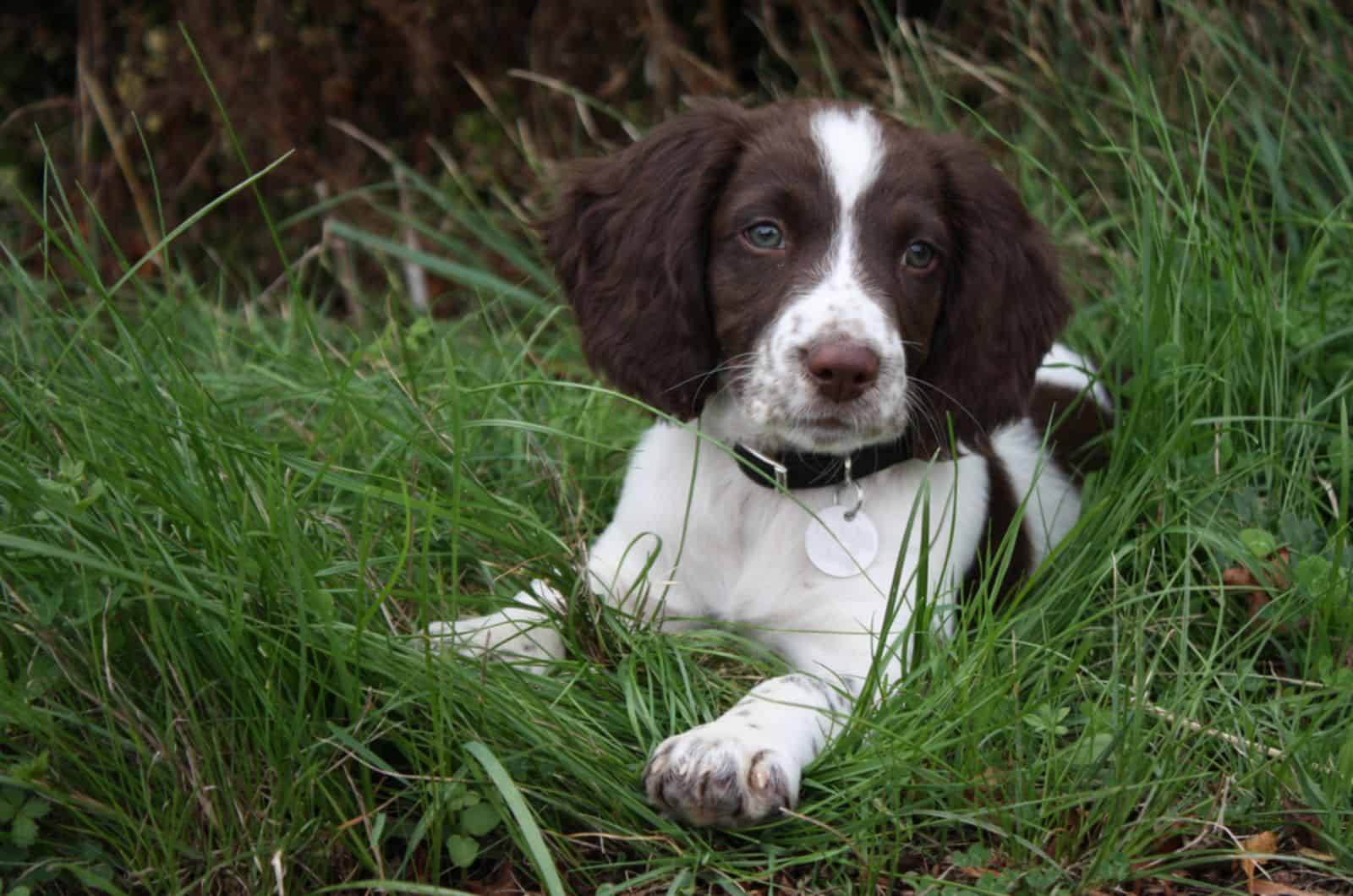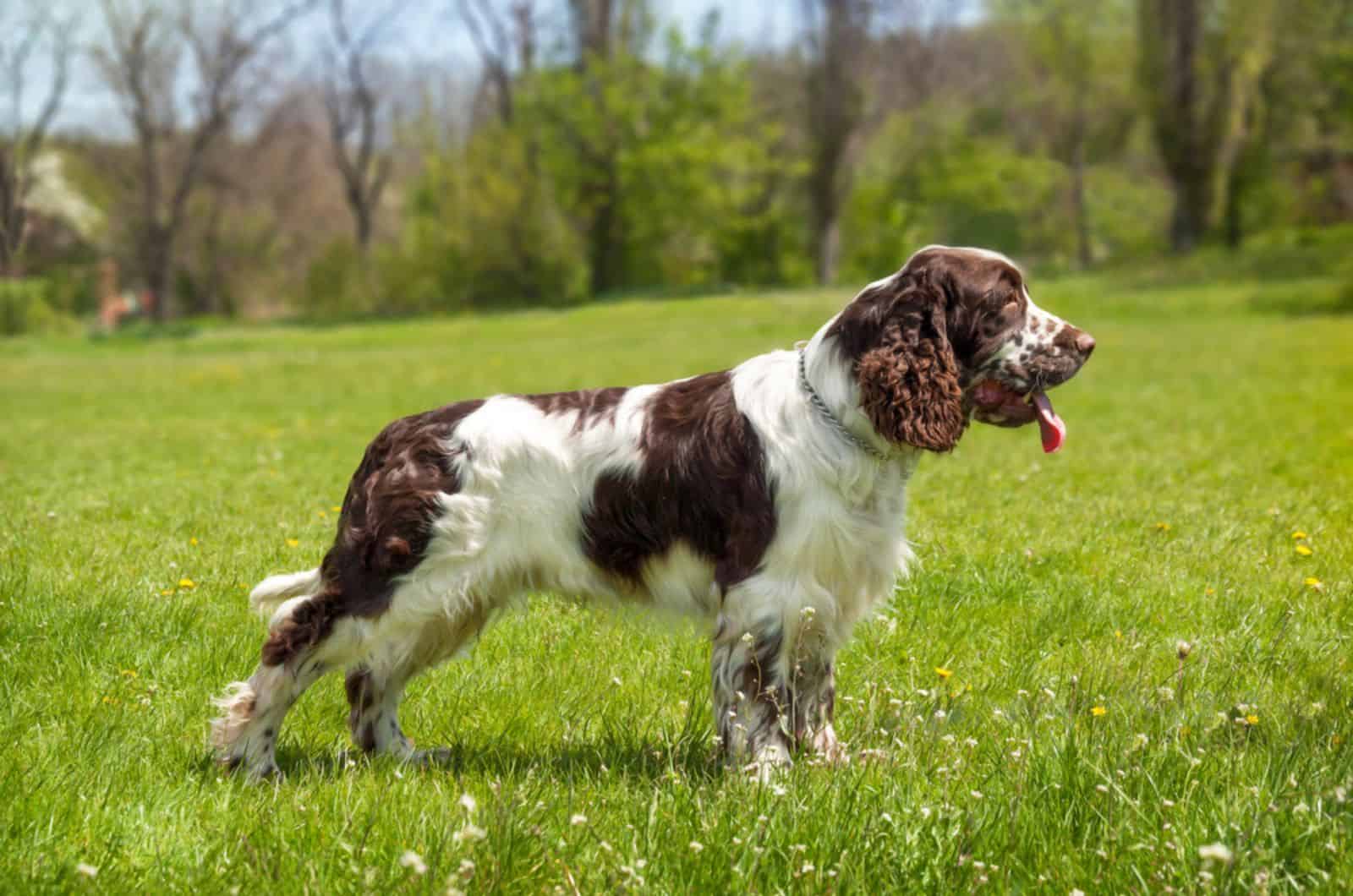The English Springer Spaniel is a friendly dog that equally enjoys hunting and lying comfortably on the sofa. They have gorgeous fur and big, dark eyes on an elegant, elongated head.
Don’t forget their long ears as well… But, did you know that these dogs can grow up to twenty inches tall, and that they can weigh more than fifty pounds?
They sure can! And, that puts them in the medium-sized dog group. As you know, each dog is unique, which means some Springer Spaniel dogs can be around 40 pounds or 45… but, some average weight and height measures can be expected during puppy growth.
These average measures can be put together and made into a Springer Spaniel growth chart to help pet owners determine the weight of their lovely canines and see if everything is alright.
An average dog’s weight and any divergences can be good indicators to check out a dog’s health. Of course, the size depends on the dog breed and activity as well as many other internal and external factors.
But, we can still use an approximate and expected weight to determine if our dog is of the right weight and in good shape.
From Springer Spaniel puppies to adult weight — this is the ultimate monthly guide. Let’s see if your energetic Springer has proper weight chart results.
Springer Spaniel Growth Chart

Almost all dogs that belong to the sporting group have some weight and height differences between a male and a female dog. These differences are not very big, but they have to be mentioned. For a better view of the Springer Spaniel growth chart, we’ve put them into separate charts.
This is the average dog weight chart that, combined with the appropriate height a dog reaches in adulthood, can tell you if the size of your Springer Spaniel is appropriate. In other words, you can use it to see if the weight of your English Springer Spaniel falls under a healthy weight.
We will talk about the external and internal factors that can change the growth chart, and if there is anything we can do about it. For now, let’s check out the numbers…
Springer Spaniel Growth Chart For A Male
| Age (months) | Weight (lb) | Weight (kg) |
|---|---|---|
| 3 | 17 – 22 | 7 – 9 |
| 4 | 23.5 – 28 | 10 – 12 |
| 5 | 30 – 32.5 | 13 – 14.5 |
| 6 | 34 – 37 | 15 – 17 |
| 7 | 37 – 40.5 | 17 – 18 |
| 8 | 40.5 – 42 | 18-19 |
| 9 | 42 – 43.5 | 19-20 |
| 10 | 43.5 – 45.5 | 20 – 21 |
| 11 | 46 – 49 | 21 – 23 |
| 12 | 49 – 53 | 23 – 25 |
* The average height of an adult male Springer Spaniel is up to 20 inches.
Springer Spaniel Growth Chart For A Female
| Age (months) | Weight (lb) | Weight (kg) |
|---|---|---|
| 3 | 16.5-19 | 7-8 |
| 4 | 19-22 | 7-10 |
| 5 | 22-24 | 10-11 |
| 6 | 24-26.5 | 11-12.5 |
| 7 | 26.5-28 | 12.5-13.5 |
| 8 | 28-30 | 13.5-14 |
| 9 | 30-32 | 14-15.5 |
| 10 | 32-35 | 15.5-16.5 |
| 11 | 35-38 | 16.5-17 |
| 12 | 38-43 | 17-20 |
* The average height of a Springer Spaniel female dog is up to 19 inches.
Springer Spaniel Growth Through Different Life Stages

As you can see from the growth chart above, there are some differences between a male and a female Springer Spaniel. In general, a male Springer is slightly taller than a female, but it can weigh much more.
The difference in weight can be quite noticeable if you have a female that is at the bottom line of the average weight, and a male that is on the upper line. That means there can be a difference of almost 20 pounds between these two dogs!
But, keep in mind that sometimes a male can be smaller than a female, especially in puppyhood. This doesn’t necessarily mean that your dog is not normal. There are many factors that can influence the dog’s size, and we will mention them and explain them all later.
Right now, let’s focus on each life stage of a Springer Spaniel, and what it means in terms of their normal weight. What should we expect… or, in other words — is my Springer Spaniel achieving all the growth milestones?
Birth To 3 Months
When the puppies are born, they are blind and deaf, and they can only use their sense of smell to find the much-needed warmth and milk from their mom. The average weight of newly-born Springer Spaniel puppies is from 5 to 10 pounds.
As we’ve already mentioned, usually, the female puppies will be a bit smaller than the males, but when they are as small as this, the rule doesn’t have to apply, and their weighings are approximately the same.
But, this is a crucial period for baby dogs, no matter if you have a German Shepherd, a Cocker Spaniel, or some small dog breed.
This is the period when they have to drink their first milk called colostrum, which is rich in antibodies. These first antibodies are very important for the puppies’ immune system.
But, as time goes on, the puppies will get larger, and by the end of the first week of their life — they should double in size. You can use this information to check if the baby dogs are developing appropriately, and if they are receiving the proper nutrition in these crucial few days after the birth.
If you feel like some of the puppies are underweight or seem much smaller than the rest of the litter — you can consult a veterinarian about appropriate puppy food formulas you can give them as supplemental food.
Weaning Process
This also happens during the first three months, and it is a very important period. It’s also a bit of a shock for the puppies. All of a sudden, they can’t drink their mother’s milk anymore, and they have to deal with other types of food.
It is, of course, a natural way of things, and as such — inevitable. We can help the puppies in this period by introducing solid puppy dog food. The important thing during this period is to free-feed the pups.
Free-feeding means you leave the food available for the puppies to eat whenever they feel like it. They are still looking for their mom as the main source of food (milk), but she will soon completely start to avoid them, and they will have to turn to the solid food you give them.
You can make this period much easier for your dogs by making puppy mush. To make puppy mush, all you need to do is soften the kibble (dry dog food) in milk or warm water. This way, a puppy that still has just small baby teeth can nibble on those delicious kibbles.
As the puppies reach the end of the second month and step into the big three months of age, they will be getting bigger and much sturdier.
3 To 4 Months

At the beginning of the third month, the Springer Spaniel growth chart shows us that the male pups will already be quite larger than the female pups. They will weigh up to 22 pounds, and females, up to 19 pounds.
But, this period is important for another reason. It is the perfect time to start the proper socialization of your puppies. You can use different types of food, and make a puppy schedule to teach them new rules easier.
Dogs love to eat, so giving them food as a reward is a good way to teach them what is good behavior, and what is a big no-no. Of course, you have to keep an eye on the puppy weight chart and maintain a balanced diet.
The reason why this period of a puppy’s life is good for socialization is that their gray cells act as little sponges. They soak up everything! They remember the smells, learn that a vacuum cleaner is not a scary monster (or, it is?!), and learn that a parrot is not a delicious treat.
You have to be extra careful with small animals when it comes to Springer Spaniels because they were bred to be hunting dogs — the bird-hunting dogs!
All of this brain work means they will need a lot of healthy fats in their diet to support their rapidly growing body and their overtime-working brains. You can consult the vet to find out what the best way is to add healthy fats to your puppies’ diet.
Teething Period
There is another important process that starts during this period. It is teething — a small nuisance for dogs, and a big one for owners if we don’t teach the pups on time that chewing everything is a bad thing!
But, most importantly, teething can affect food intake for a while. Because teething might be uncomfortable, the puppies can start eating slower and less than usual. They can also show other signs telling us something is bothering them, like crying while playing or completely stopping eating!
Even if this might sound alarming — it will all pass. And, these changes certainly do not influence the Springer Spaniel growth chart. So, this means that you don’t have to change the puppies’ diet completely. You can just keep on making puppy mush to help them eat more comfortably.
All of these changes will pass as soon as the teething process ends. Besides making puppy mush, you can help the puppies by giving them cooled carrots to bite. The low temperature has a soothing effect on inflamed gums.
5 To 6 Months
When they reach the fifth month of age, female Springer Spaniel dogs should weigh from 22 to 24 pounds. Males are still far ahead — weighing up to 32.5 pounds.
Your dog is slowly approaching the so-called teenage phase that starts at the end of the sixth month for English Springer Spaniel dogs and other medium-sized dogs.
They are almost half their adult size, which means that this is still a period of rapid growth. They need a well-balanced diet full of proteins, vitamins, and minerals. This is also a period in which your puppies should know the basic rules of good behavior.
Another thing to look out for is the female’s behavior. Sometimes, a female dog of medium size can become sexually mature at the age of six months. They can show signs that are unique to male dogs, such as humping.
But, generally, you will see that the female dog is much more affectionate, and is seeking attention from male dogs — if you have more than one dog.
According to the American Kennel Club, the rule for neutering and spaying your dogs at the age of six months no matter the breed is no longer valid. Spaying and neutering depend on the breed and the dog itself.
If you got a dog from a breeder, you can ask them when to expect dogs to become sexually mature.
7 To 8 Months

This is the teenage phase we’ve talked about. When a puppy enters the seventh month, the adolescent phase kicks in. This means they become a lot more active.
They are constantly trying out their moves, sniffing, running, barking, and returning to old habits that they (should have) learned. It can be quite a mess and difficult to keep your pups in order — both mentally and physically.
But, don’t worry too much. This is a phase, and it will pass, which means the puppies will get easier. The important thing is that your dog’s weight is in accordance with the Springer Spaniel growth chart. Males should be weighing from 37 to 42 pounds, and females, from 26.5 to 30.
If you were wondering how big Springer Spaniels get — this is not it. They still have time to grow and put on a couple of pounds more. But, they do certainly look like adult Springer Spaniels with each day passing.
They sure look like mini versions of adult Springers, but they are still puppies, and they can still cause some puppy blues in every owner. There is nothing to be ashamed of — puppy blues are a real thing, and it can happen to the best of us.
As they approach their 10th month, the pups will gradually get out of the teenage phase and enter a more serious one, resembling future Show dogs, where you won’t have to ask yourself, What have I gotten myself into?
9 To 10 Months
The Springer Spaniel puppies have entered the phase where they truly look like adult dogs. Of course, they will still grow.
According to the Springer Spaniel growth chart, male dogs should be up to 45.5 pounds at the end of the tenth month. Females are still smaller — up to 35 pounds. But, if you have a ten-month old male Springer Spaniel that weighs more than 45 pounds, there is nothing wrong.
As long as the weight is not drastically different from the average, there are no problems. Dogs can exhibit signs of obesity when they are puppies, but it is primarily an adult-age problem for dogs.
But, you should keep an eye on the chart and pay attention to your dog’s weight. It is more important that the dog is not underweight during this growth period than overweight. It could be a sign of a more serious underlying problem.
If you notice your dog is underweight, the best option is to take the puppy to the vet. It might be nothing, but it is always better to be safe than sorry when it comes to those we love.
This is also the time to start thinking about neutering your dog. Most breeders recommend neutering your male Springer Spaniel around the age of 9 or 10 months. You can do it later, when they reach one year.
But, if you notice signs that your dog needs to be neutered, there’s nothing to wait for. They reached their sexual maturity, and if your vet gives the green light and you don’t plan on breeding your dogs, then go for it.
At the end of the tenth month, puppies can still show signs of the dreaded teenage phase, but they should be starting to calm down. These behavioral changes are individual, and they can vary from dog to dog.
Each dog has its own personality, which can make them stand out from the average. We are focusing on their weight chart. The temperament of your dog is something that depends on the dog’s breed, socialization, your influence on the dog, and the dog’s unique set of genes.
11 To 12 Months

Both female and male Springer Spaniel dogs should be almost the same weight as adult dogs. They are also the same height. They might grow a bit taller, but as for their height — this is it. Females are up to 19 inches tall, and males are up to 20 inches tall.
The weight is different, especially for males. They can still put on some weight. According to the Springer Spaniel growth chart, male dogs should weigh from 46 to 49 pounds by the end of the 11th month. Female Springer Spaniels should weigh from 35 to 38 pounds.
So, you should have a clear picture of how big your dog will be when it turns one year old. Some dogs stop growing when they turn 11 months old, but most of them continue growing a bit more.
In general, when they reach adulthood, Springer Spaniel male dogs should weigh from 49 to 53 pounds. Females are smaller — from 38 to 43 pounds.
Even though you have dogs that are almost adult, and they look like adults, they still need quality puppy food. The protein intake still has to be higher than the intake of carbohydrates. You can achieve this by giving your dogs high-quality food.
We will mention the types of diets for your dog later. At this time, keep in mind that 11-month-old puppies are just that — puppies. They should transition to adult dog food when they reach one year of life.
Adult Years
By the time they reach twelve months of age, the Springer Spaniel male dogs are around 50 pounds, and up to 20 inches tall. Females are around 40 pounds, and up to 19 inches tall.
Some slight variations in weight can happen, but as for their height — there are no changes. Your dog will have a double, medium-length coat, long, fluffy ears, and a quite sturdy body for a Springer.
Even though the dog has stopped growing, it can still gain weight, or better yet — become overweight. From this period on, it is important to keep your dog’s diet balanced, and give your dog plenty of exercise.
Adult dogs should also be spayed or neutered if you don’t plan on breeding them. There are pros and cons when it comes to spaying and neutering, but generally, it helps your dog’s health, and it lowers the population of stray dogs.
Fewer stray dogs means fewer puppies in animal shelters.
So, to sum it up – according to the Springer Spaniel growth chart, an adult male should weigh from 49 to 53 pounds (23-25kg), and be up to 20 inches tall. An adult female Springer Spaniel should weigh from 38 to 43 pounds (17-20kg), and be up to 19 inches tall.
That being said, let’s take a look at what might influence and change the growth chart.
What Can Influence Springer Spaniel Growth?

The chart we saw was made for an average English Springer Spaniel dog, both males and females. The average also means that the dogs are healthy and without serious health problems, genetic influences, dietary changes, etc.
All of these factors have a certain impact on the dog’s size — weight and height. Truth be told, most issues influence weight. But, there are some issues that can change the dog’s height as well.
Some factors that change the growth process can be easily treated and, unfortunately, some cannot be treated at all. There are also factors that have very little influence on the dog’s size, but there are also those with a bigger influence.
Here are the factors with the biggest influence on the Springer Spaniel Growth chart.
1. Cancer
This is a health factor that can rapidly change the dog’s weight. Depending on the affected organ or body part, cancer can have a more rapid or less rapid influence.
But, eventually, every form leads to a loss of weight that is noticeable, especially on the rib cage, and abdomen of the dog. If cancer has been diagnosed early during its first stages, the prognosis can be good.
Unfortunately, just like with humans, this is a serious disease that can rapidly grow and metastasize in other parts of the body making the treatment hard and the prognosis uncertain.
2. Parasites
There are two most common types of parasites in dogs that can change the dog’s growth process. They are called roundworms and hookworms.
I am sure you have heard of these parasites before. They are quite common and a procedure called deworming is regularly done on puppies and adult dogs. There are spot-on or oral medications to treat parasitic worms.
These parasites can wait for a perfect opportunity burrowed in the ground for months. Once the puppy or a dog licks the infected ground, the parasite will latch onto the inner layer of the small intestines of a dog.
Both types of these parasitic worms eat partially-digested food from the small intestine of a dog. They can get overpopulated and seriously damage the puppy by devouring all the food the dog has already eaten.
Such a process leads to a loss of weight in a dog. But, it can also have other symptoms:
- Rough and thin fur
- Pot-belly
- Dog not gaining weight even though they eat a lot
The good thing is that once the worms are out of the body, the dog returns to its normal state. That’s why regular deworming is a necessary procedure for your puppy’s and your adult dog’s health!
3. Genetics
Even though your dog looks like a Springer Spaniel, and everything is according to the AKC standards, as far as you can see — they have a size typical of another dog breed. What’s that all about?
Well, blame it on genes.
Unless you ask for a pedigree or a DNA test, you can never be certain that your English Springer Spaniel you bought from a “reputable” breeder is actually a purebred dog.
This means that you can have a Springer puppy that has other dog breed genes in its gene pool, which can alter the growing process.
Maybe you have a much larger Springer Spaniel than it should be, according to the Springer Spaniel growth chart. Or, maybe it is much smaller than the average dog of this breed. If you are really interested, you can do the DNA test and find out if your doggo is a purebred.
4. Neutering/Spaying
Whether neutering or spaying can change the weight and height of a dog has been an ongoing debate for years. Some people say it can – others claim it has no influence.
The debate revolves around possible joint problems. Vets recommend neutering/spaying your dog earlier… when they are around six months of age. But, this is still a time of rapid growth for Spaniels and other medium and large dogs.
This can make your dog grow taller than it should be because the lack of sex hormones in the bloodstream delays the closure of the growth plates. This is what leads to the mentioned joint problems.
One thing is certain – spaying or neutering your dog is something you should do in consultation with your vet. They can examine your dog and decide when the right time is.
The Conclusion
The Springer Spaniel is a medium-sized dog that has quite a size difference between a male and a female. Most males are around 50 pounds when they reach adulthood, while females are around 40 pounds.
We saw in the Springer Spaniel growth chart that these numbers vary. They are not precisely 50 pounds and 40 pounds, but an average number depending on the sex of the puppy and their age.
These charts are of great value because they give you excellent insight into what is normal and what is considered not normal when it comes to the Springer Spaniel’s size.
All dogs go through rapid changes throughout puppyhood, but they should all be inside the average numbers. If you notice your dog stands out too much, whether by being overweight or underweight, take it to the vet.
There might be some internal or external factors influencing your dog’s growth. For example, a health issue or genetics.
It might not be a serious problem or a problem at all, but it will ease your mind, and you will know you are taking excellent care of your doggo — just like they all deserve.













